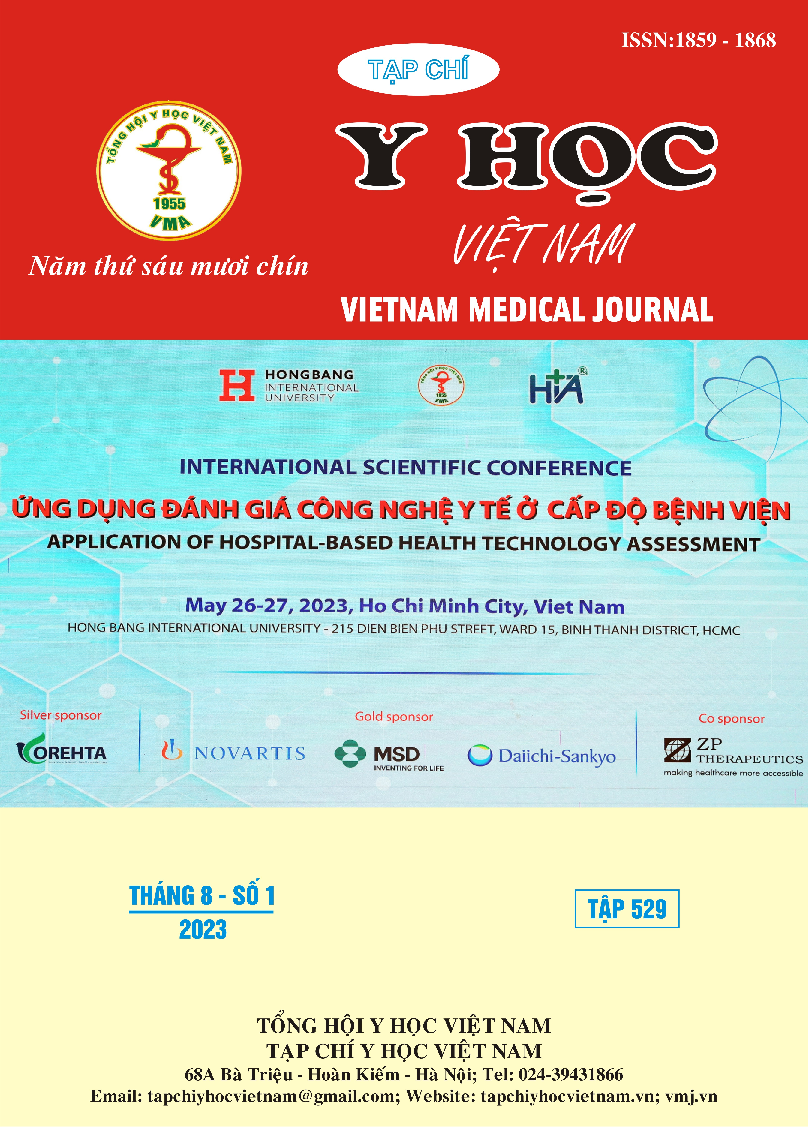ĐÁNH GIÁ KẾT QUẢ ỨNG DỤNG PHẪU THUẬT NỘI SOI Ổ BỤNG ĐIỀU TRỊ TẮC RUỘT NON DO BÃ THỨC ĂN TẠI BỆNH VIỆN QUÂN Y 103
Nội dung chính của bài viết
Tóm tắt
Mục tiêu: đánh giá kết quả ứng dụng phẫu thuật nội soi điều trị tắc ruột non do bã thức ăn. Đối tượng và phương pháp nghiên cứu: nghiên cứu cắt ngang, hồi cứu trên 76 bệnh nhân được chẩn đoán tắc ruột non do bã thức ăn và được ứng dụng phẫu thuật nội soi ổ bụng để điều trị tại Bệnh viện Quân y 103 giai đoạn từ 05/2018 đến 10/2022. Kết quả: Tắc ruột do bã thức ăn vị trí ở hồi tràng, hỗng tràng, hỗng tràng + hồi tràng lần lượt là 43,4%, 51,3%, và 5,3%. Bã thức ăn ở 1 vị trí chiếm đa số 94,7%, ở 2 vị trí chiếm 5,3%. Phẫu thuật nội soi hoàn toàn (39,5%), phẫu thuật nội soi hỗ trợ (60,5%). Đẩy bã thức ăn xuống đại tràng được áp dụng cho 36,8% trường hợp, mở ruột lấy bã thức ăn được áp dụng cho 63,2%. Phẫu thuật nội soi hoàn toàn và nội soi hỗ trợ giúp bệnh nhân sớm phục hồi sớm, thời gian ăn sau mổ trung bình của 2 nhóm lần lượt là 2,38 ± 0,78 ngày và 3,55 ± 1,49 ngày, thời gian nằm viện trung bình sau mổ lần lượt là 5,17 ± 1,76 ngày và 7,13 ± 4,90 ngày. Tỷ lệ tai biến, biến chứng sau mổ thấp, rách thanh mạc ruột 6,5%, nhiễm khuẩn vết mổ 2,6%, tắc ruột sớm sau mổ 1,3%. Kết luận: Ứng dụng phẫu thuật nội soi điều trị tắc ruột do bã thức ăn ở nhóm bệnh nhân lựa chọn là an toàn, khả thi, giúp bệnh nhân nhanh phục hồi, tỷ lệ tai biến, biến chứng thấp.
Chi tiết bài viết
Từ khóa
phẫu thuật nội soi, tắc ruột non, bã thức ăn
Tài liệu tham khảo
2. Krausz, M.M., et al., Surgical aspects of gastrointestinal persimmon phytobezoar treatment. Am J Surg, 1986. 152(5): p. 526-30.
3. Yang, S. and M.J. Cho, Clinical Characteristics and Treatment Outcomes Among Patients With Gastrointestinal Phytobezoars: A Single-Institution Retrospective Cohort Study in Korea. Front Surg, 2021. 8: p. 691860.
4. Altintoprak, F., et al., Intestinal obstruction due to bezoars: a retrospective clinical study. Eur J Trauma Emerg Surg, 2012. 38(5): p. 569-75.
5. Yau, K.K., et al., Laparoscopic approach compared with conventional open approach for bezoar-induced small-bowel obstruction. Arch Surg, 2005. 140(10): p. 972-5.
6. Ganpathi, I.S. and W.K. Cheah, Laparoscopic-assisted management of small bowel obstruction due to phytobezoar. Surg Laparosc Endosc Percutan Tech, 2005. 15(1): p. 30-2.
7. de Menezes Ettinger, J.E., et al., Laparoscopic management of intestinal obstruction due to phytobezoar. Jsls, 2007. 11(1): p. 168-71.
8. Dirican, A., et al., Surgical treatment of phytobezoars causes acute small intestinal obstruction. Bratisl Lek Listy, 2009. 110(3): p. 158-61.


